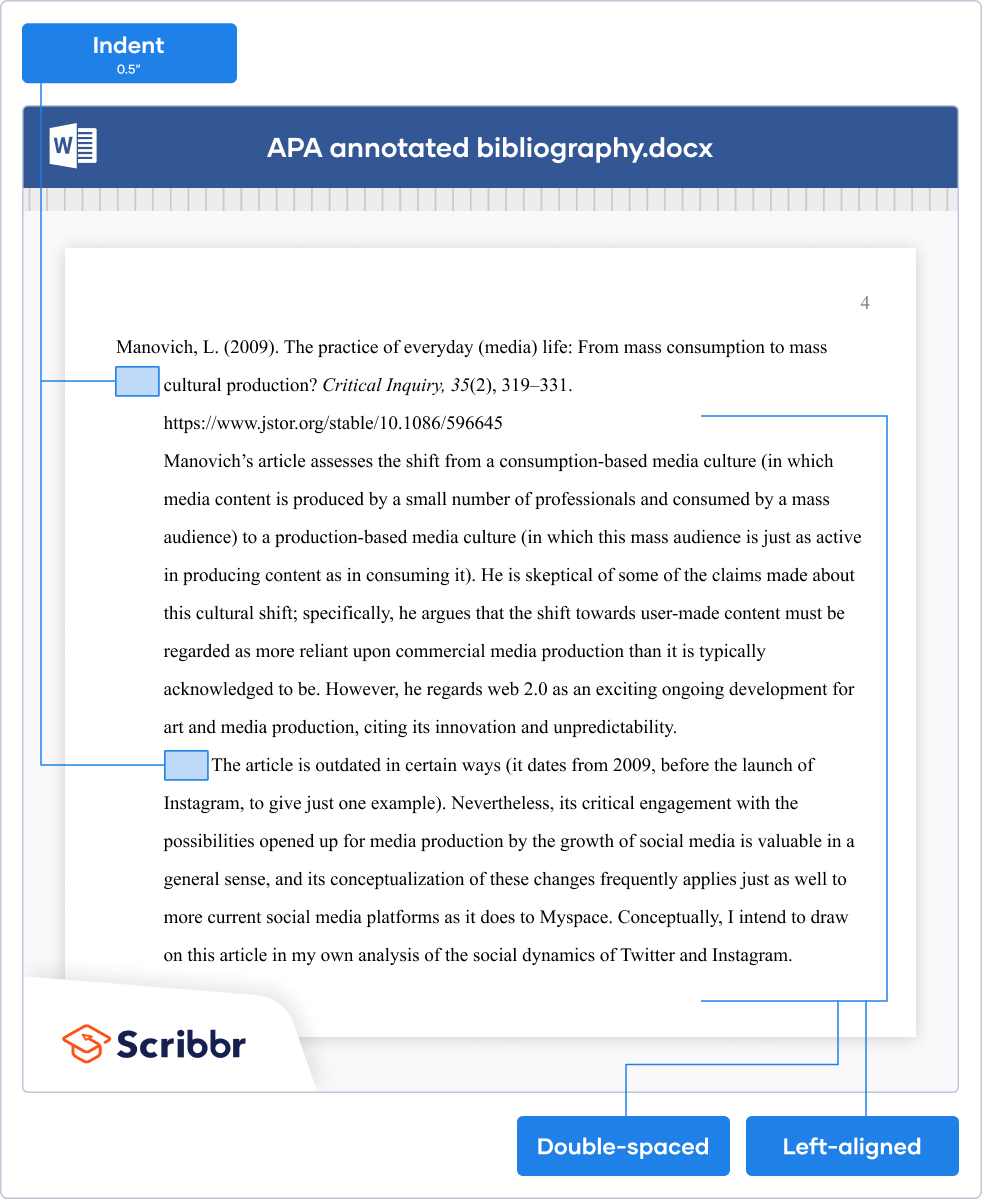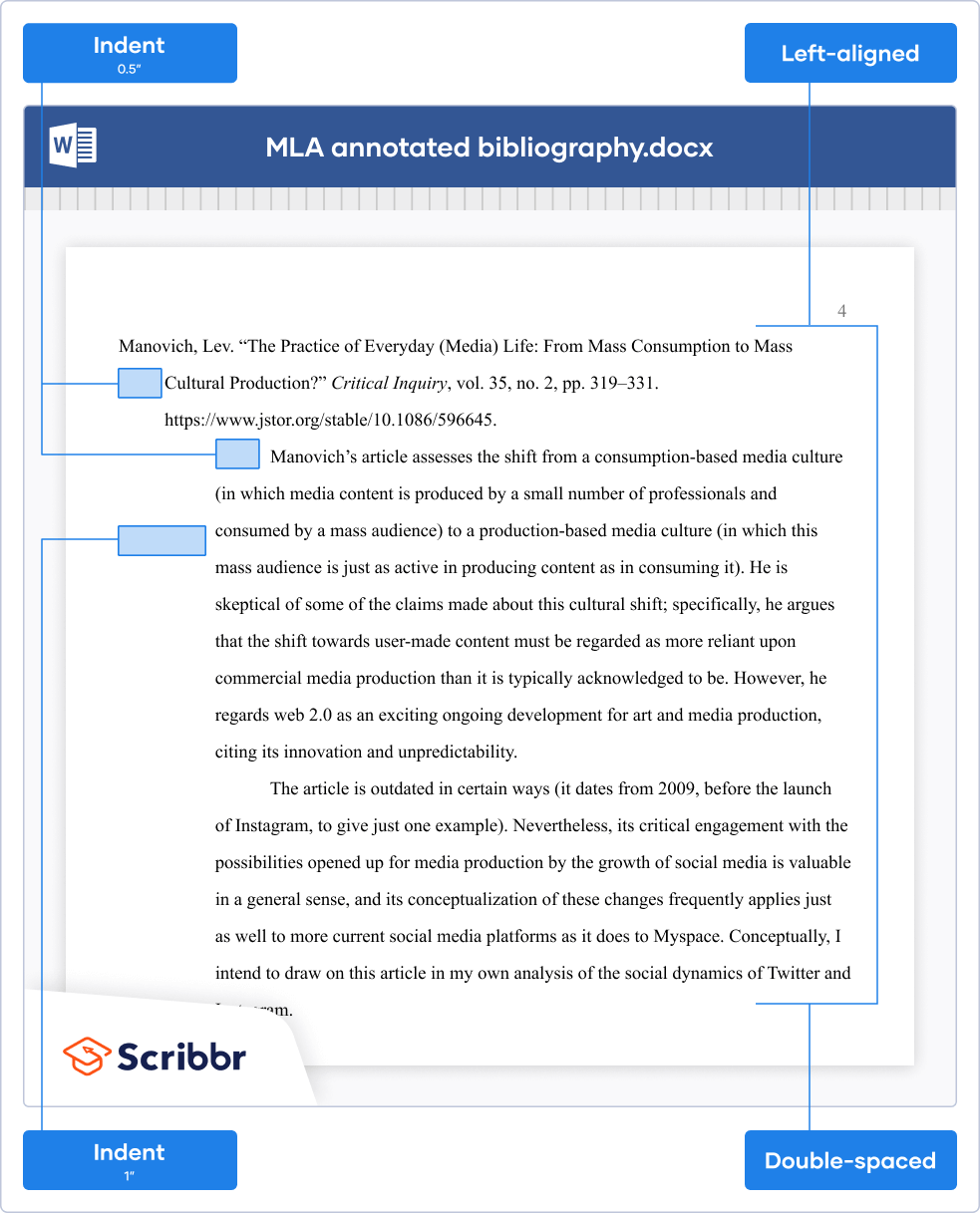What Is an Annotated Bibliography? | Examples & Format
An annotated bibliography is a list of source references that includes a short descriptive text (an annotation) for each source. It may be assigned as part of the research process for a paper, or as an individual assignment to gather and read relevant sources on a topic.
Scribbr’s free Citation Generator allows you to easily create and manage your annotated bibliography in APA or MLA style. To generate a perfectly formatted annotated bibliography, select the source type, fill out the relevant fields, and add your annotation.
An example of an annotated source is shown below:
Annotated bibliography format: APA, MLA, Chicago
Make sure your annotated bibliography is formatted according to the guidelines of the style guide you’re working with. Three common styles are covered below:
APA Style
In APA Style, both the reference entry and the annotation should be double-spaced and left-aligned.
The reference entry itself should have a hanging indent. The annotation follows on the next line, and the whole annotation should be indented to match the hanging indent. The first line of any additional paragraphs should be indented an additional time.
The APA Citation Generator automatically formats your annotations when you download your bibliography.
MLA style
In an MLA style annotated bibliography, the Works Cited entry and the annotation are both double-spaced and left-aligned.
The Works Cited entry has a hanging indent. The annotation itself is indented 1 inch (twice as far as the hanging indent). If there are two or more paragraphs in the annotation, the first line of each paragraph is indented an additional half-inch, but not if there is only one paragraph.
If you’re using the MLA Citation Generator, your annotations will be correctly formatted when you download your bibliography.
Chicago style
In a Chicago style annotated bibliography, the bibliography entry itself should be single-spaced and feature a hanging indent.
The annotation should be indented, double-spaced, and left-aligned. The first line of any additional paragraphs should be indented an additional time.
How to write an annotated bibliography
For each source, start by writing (or generating) a full reference entry that gives the author, title, date, and other information. The annotated bibliography format varies based on the citation style you’re using.
The annotations themselves are usually between 50 and 200 words in length, typically formatted as a single paragraph. This can vary depending on the word count of the assignment, the relative length and importance of different sources, and the number of sources you include.
Consider the instructions you’ve been given or consult your instructor to determine what kind of annotations they’re looking for:
- Descriptive annotations: When the assignment is just about gathering and summarizing information, focus on the key arguments and methods of each source.
- Evaluative annotations: When the assignment is about evaluating the sources, you should also assess the validity and effectiveness of these arguments and methods.
- Reflective annotations: When the assignment is part of a larger research process, you need to consider the relevance and usefulness of the sources to your own research.
These specific terms won’t necessarily be used. The important thing is to understand the purpose of your assignment and pick the approach that matches it best. Interactive examples of the different styles of annotation are shown below.
Descriptive annotation example
A descriptive annotation summarizes the approach and arguments of a source in an objective way, without attempting to assess their validity.
In this way, it resembles an abstract, but you should never just copy text from a source’s abstract, as this would be considered plagiarism. You’ll naturally cover similar ground, but you should also consider whether the abstract omits any important points from the full text.
The interactive example shown below describes an article about the relationship between business regulations and CO2 emissions.
Rieger, A. (2019). Doing business and increasing emissions? An exploratory analysis of the impact of business regulation on CO2 emissions. Human Ecology Review, 25(1), 69–86. https://www.jstor.org/stable/26964340
Evaluative annotation example
An evaluative annotation also describes the content of a source, but it goes on to evaluate elements like the validity of the source’s arguments and the appropriateness of its methods.
For example, the following annotation describes, and evaluates the effectiveness of, a book about the history of Western philosophy.
Kenny, A. (2010). A new history of Western philosophy: In four parts. Oxford University Press.
Here's why students love Scribbr's proofreading services
Reflective annotation example
A reflective annotation is similar to an evaluative one, but it focuses on the source’s usefulness or relevance to your own research.
Reflective annotations are often required when the point is to gather sources for a future research project, or to assess how they were used in a project you already completed.
The annotation below assesses the usefulness of a particular article for the author’s own research in the field of media studies.
Manovich, Lev. (2009). The practice of everyday (media) life: From mass consumption to mass cultural production? Critical Inquiry, 35(2), 319–331. https://www.jstor.org/stable/10.1086/596645
Manovich’s article assesses the shift from a consumption-based media culture (in which media content is produced by a small number of professionals and consumed by a mass audience) to a production-based media culture (in which this mass audience is just as active in producing content as in consuming it). He is skeptical of some of the claims made about this cultural shift; specifically, he argues that the shift towards user-made content must be regarded as more reliant upon commercial media production than it is typically acknowledged to be. However, he regards web 2.0 as an exciting ongoing development for art and media production, citing its innovation and unpredictability.
The article is outdated in certain ways (it dates from 2009, before the launch of Instagram, to give just one example). Nevertheless, its critical engagement with the possibilities opened up for media production by the growth of social media is valuable in a general sense, and its conceptualization of these changes frequently applies just as well to more current social media platforms as it does to Myspace. Conceptually, I intend to draw on this article in my own analysis of the social dynamics of Twitter and Instagram.
Finding sources for your annotated bibliography
Before you can write your annotations, you’ll need to find sources. If the annotated bibliography is part of the research process for a paper, your sources will be those you consult and cite as you prepare the paper. Otherwise, your assignment and your choice of topic will guide you in what kind of sources to look for.
Make sure that you’ve clearly defined your topic, and then consider what keywords are relevant to it, including variants of the terms. Use these keywords to search databases (e.g., Google Scholar), using Boolean operators to refine your search.
Sources can include journal articles, books, and other source types, depending on the scope of the assignment. Read the abstracts or blurbs of the sources you find to see whether they’re relevant, and try exploring their bibliographies to discover more. If a particular source keeps showing up, it’s probably important.
Once you’ve selected an appropriate range of sources, read through them, taking notes that you can use to build up your annotations. You may even prefer to write your annotations as you go, while each source is fresh in your mind.
Frequently asked questions about annotated bibliographies
- What is an annotated bibliography?
-
An annotated bibliography is an assignment where you collect sources on a specific topic and write an annotation for each source. An annotation is a short text that describes and sometimes evaluates the source.
- What types of sources should I use in an annotated bibliography?
-
Any credible sources on your topic can be included in an annotated bibliography. The exact sources you cover will vary depending on the assignment, but you should usually focus on collecting journal articles and scholarly books. When in doubt, utilize the CRAAP test!
- How do I write an annotation for a source?
-
Each annotation in an annotated bibliography is usually between 50 and 200 words long. Longer annotations may be divided into paragraphs.
The content of the annotation varies according to your assignment. An annotation can be descriptive, meaning it just describes the source objectively; evaluative, meaning it assesses its usefulness; or reflective, meaning it explains how the source will be used in your own research.
- Is a source annotation the same thing as an abstract?
-
A source annotation in an annotated bibliography fulfills a similar purpose to an abstract: they’re both intended to summarize the approach and key points of a source.
However, an annotation may also evaluate the source, discussing the validity and effectiveness of its arguments. Even if your annotation is purely descriptive, you may have a different perspective on the source from the author and highlight different key points.
You should never just copy text from the abstract for your annotation, as doing so constitutes plagiarism.
Cite this Scribbr article
If you want to cite this source, you can copy and paste the citation or click the “Cite this Scribbr article” button to automatically add the citation to our free Citation Generator.
Caulfield, J. (2022, August 23). What Is an Annotated Bibliography? | Examples & Format. Scribbr. Retrieved January 8, 2024, from https://www.scribbr.com/citing-sources/annotated-bibliography/





